A Comparison of Rural Development Strategies in Four Countries
VerifiedAdded on 2022/10/15
|14
|3465
|19
Report
AI Summary
This report provides a comparative analysis of rural development policies and strategies implemented in France, Spain, Ireland, and Kenya, examining their historical contexts and outcomes. It delves into France's post-war agricultural modernization, Spain's transition to democracy and its agricultural challenges, Ireland's integration of tourism with rural development, and Kenya's colonial legacy and the impact of the Mau Mau rebellion. The report contrasts these experiences with South Africa's rural development journey, particularly focusing on the impact of apartheid. By comparing these diverse approaches, the report aims to offer valuable insights for policymakers seeking to develop comprehensive, holistic, and inclusive rural development strategies. The analysis covers agricultural practices, economic models, tourism integration, and the influence of historical and political factors, providing a foundation for future policy decisions.
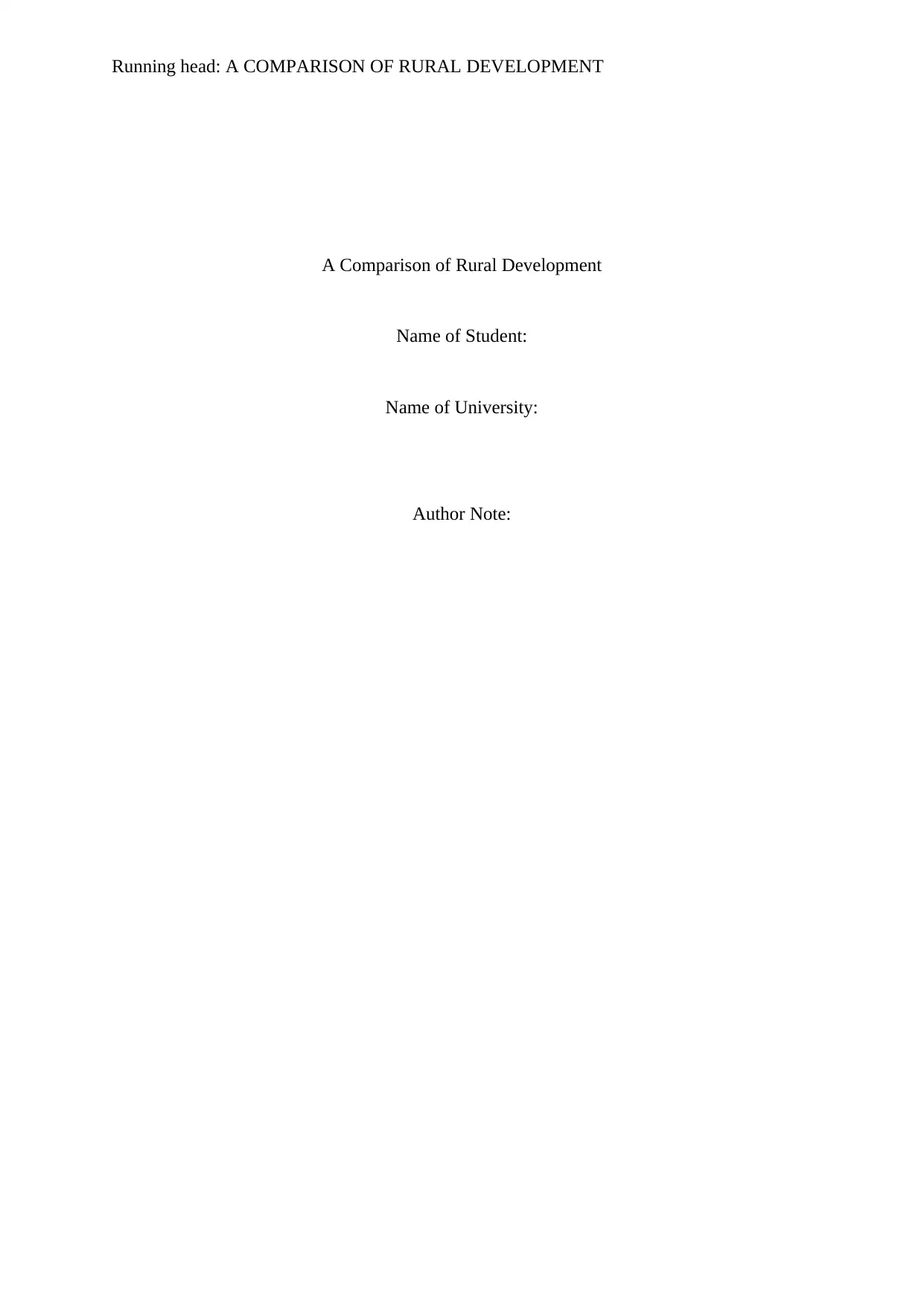
Running head: A COMPARISON OF RURAL DEVELOPMENT
A Comparison of Rural Development
Name of Student:
Name of University:
Author Note:
A Comparison of Rural Development
Name of Student:
Name of University:
Author Note:
Paraphrase This Document
Need a fresh take? Get an instant paraphrase of this document with our AI Paraphraser
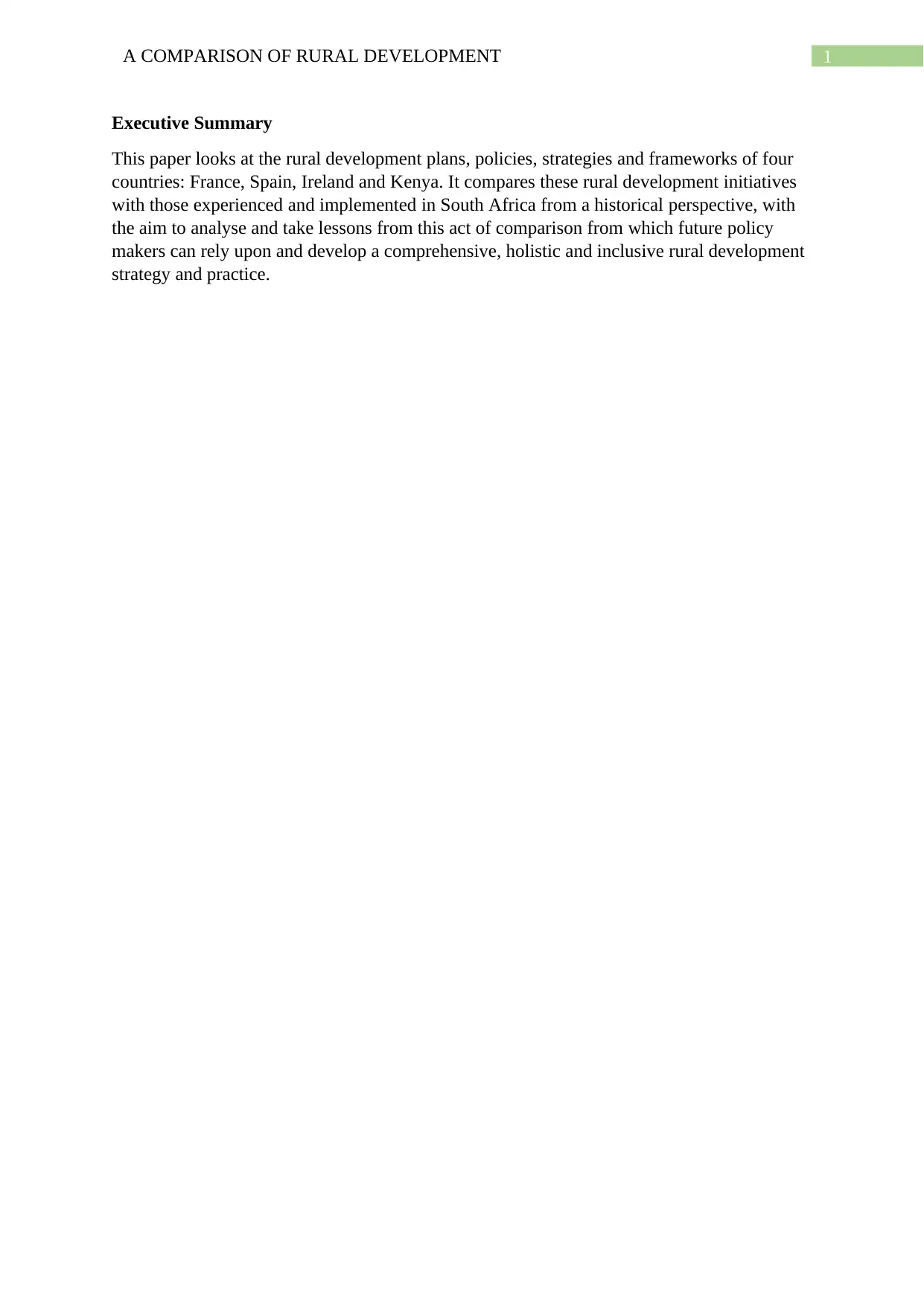
1A COMPARISON OF RURAL DEVELOPMENT
Executive Summary
This paper looks at the rural development plans, policies, strategies and frameworks of four
countries: France, Spain, Ireland and Kenya. It compares these rural development initiatives
with those experienced and implemented in South Africa from a historical perspective, with
the aim to analyse and take lessons from this act of comparison from which future policy
makers can rely upon and develop a comprehensive, holistic and inclusive rural development
strategy and practice.
Executive Summary
This paper looks at the rural development plans, policies, strategies and frameworks of four
countries: France, Spain, Ireland and Kenya. It compares these rural development initiatives
with those experienced and implemented in South Africa from a historical perspective, with
the aim to analyse and take lessons from this act of comparison from which future policy
makers can rely upon and develop a comprehensive, holistic and inclusive rural development
strategy and practice.

2A COMPARISON OF RURAL DEVELOPMENT
⊘ This is a preview!⊘
Do you want full access?
Subscribe today to unlock all pages.

Trusted by 1+ million students worldwide
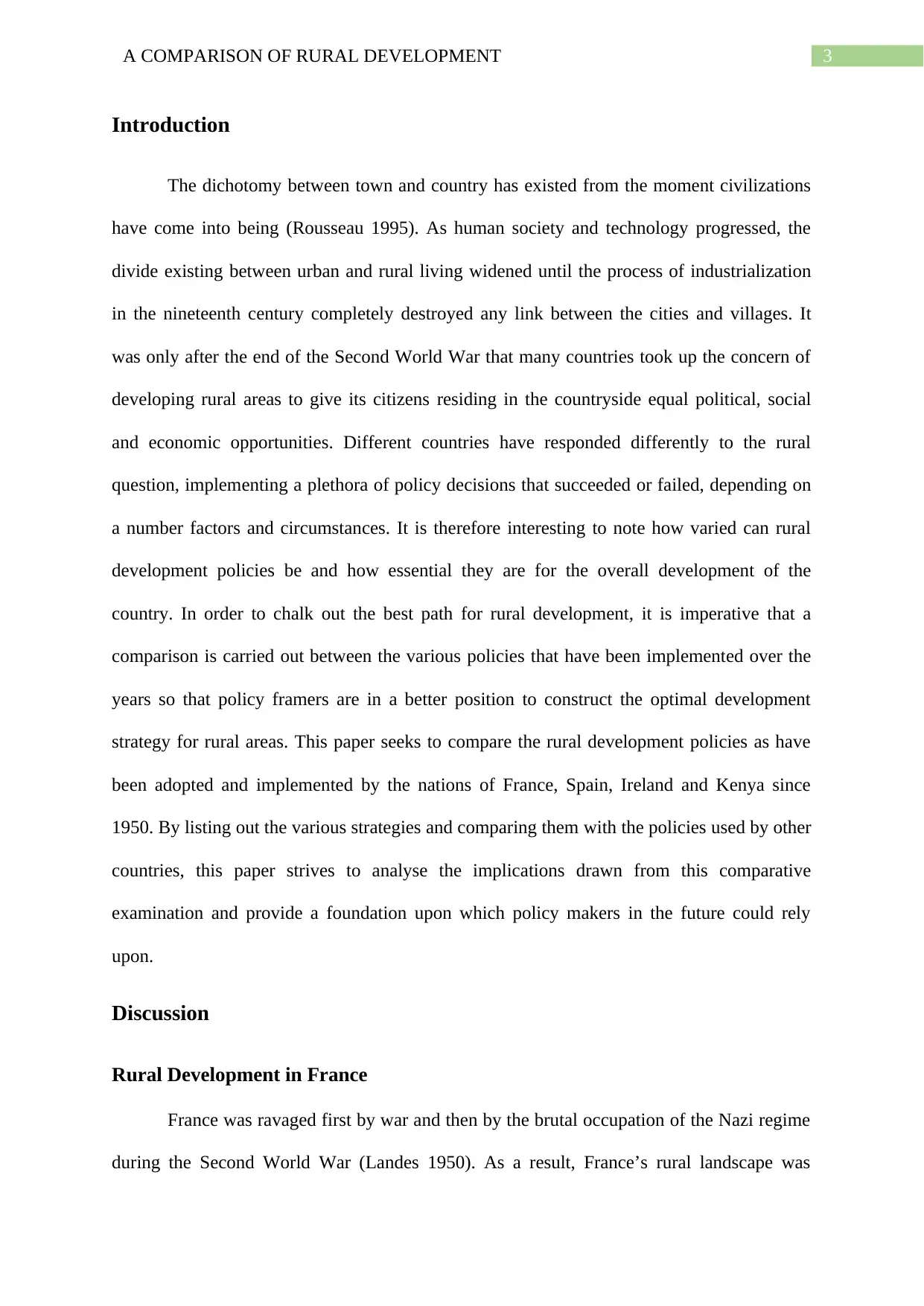
3A COMPARISON OF RURAL DEVELOPMENT
Introduction
The dichotomy between town and country has existed from the moment civilizations
have come into being (Rousseau 1995). As human society and technology progressed, the
divide existing between urban and rural living widened until the process of industrialization
in the nineteenth century completely destroyed any link between the cities and villages. It
was only after the end of the Second World War that many countries took up the concern of
developing rural areas to give its citizens residing in the countryside equal political, social
and economic opportunities. Different countries have responded differently to the rural
question, implementing a plethora of policy decisions that succeeded or failed, depending on
a number factors and circumstances. It is therefore interesting to note how varied can rural
development policies be and how essential they are for the overall development of the
country. In order to chalk out the best path for rural development, it is imperative that a
comparison is carried out between the various policies that have been implemented over the
years so that policy framers are in a better position to construct the optimal development
strategy for rural areas. This paper seeks to compare the rural development policies as have
been adopted and implemented by the nations of France, Spain, Ireland and Kenya since
1950. By listing out the various strategies and comparing them with the policies used by other
countries, this paper strives to analyse the implications drawn from this comparative
examination and provide a foundation upon which policy makers in the future could rely
upon.
Discussion
Rural Development in France
France was ravaged first by war and then by the brutal occupation of the Nazi regime
during the Second World War (Landes 1950). As a result, France’s rural landscape was
Introduction
The dichotomy between town and country has existed from the moment civilizations
have come into being (Rousseau 1995). As human society and technology progressed, the
divide existing between urban and rural living widened until the process of industrialization
in the nineteenth century completely destroyed any link between the cities and villages. It
was only after the end of the Second World War that many countries took up the concern of
developing rural areas to give its citizens residing in the countryside equal political, social
and economic opportunities. Different countries have responded differently to the rural
question, implementing a plethora of policy decisions that succeeded or failed, depending on
a number factors and circumstances. It is therefore interesting to note how varied can rural
development policies be and how essential they are for the overall development of the
country. In order to chalk out the best path for rural development, it is imperative that a
comparison is carried out between the various policies that have been implemented over the
years so that policy framers are in a better position to construct the optimal development
strategy for rural areas. This paper seeks to compare the rural development policies as have
been adopted and implemented by the nations of France, Spain, Ireland and Kenya since
1950. By listing out the various strategies and comparing them with the policies used by other
countries, this paper strives to analyse the implications drawn from this comparative
examination and provide a foundation upon which policy makers in the future could rely
upon.
Discussion
Rural Development in France
France was ravaged first by war and then by the brutal occupation of the Nazi regime
during the Second World War (Landes 1950). As a result, France’s rural landscape was
Paraphrase This Document
Need a fresh take? Get an instant paraphrase of this document with our AI Paraphraser
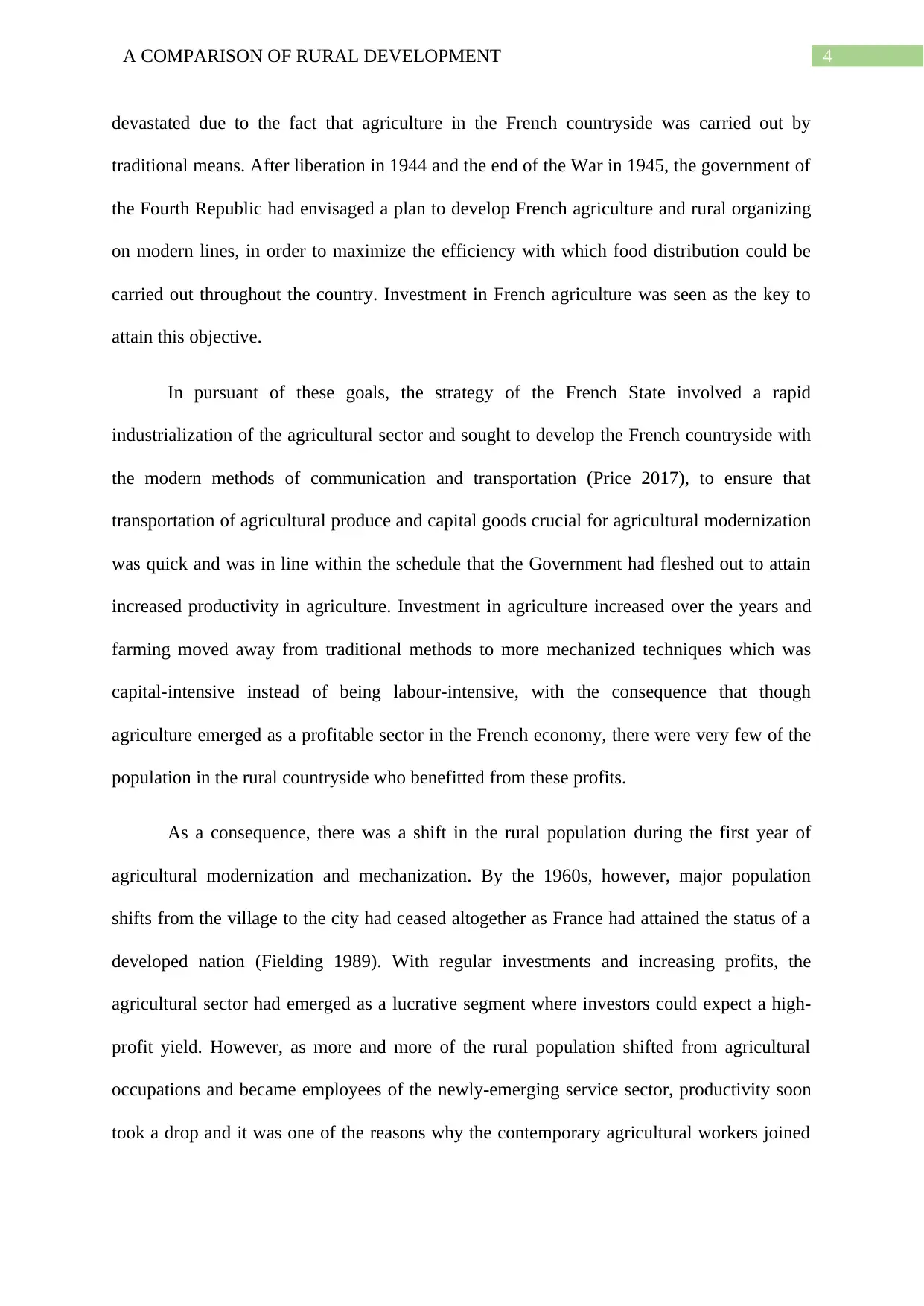
4A COMPARISON OF RURAL DEVELOPMENT
devastated due to the fact that agriculture in the French countryside was carried out by
traditional means. After liberation in 1944 and the end of the War in 1945, the government of
the Fourth Republic had envisaged a plan to develop French agriculture and rural organizing
on modern lines, in order to maximize the efficiency with which food distribution could be
carried out throughout the country. Investment in French agriculture was seen as the key to
attain this objective.
In pursuant of these goals, the strategy of the French State involved a rapid
industrialization of the agricultural sector and sought to develop the French countryside with
the modern methods of communication and transportation (Price 2017), to ensure that
transportation of agricultural produce and capital goods crucial for agricultural modernization
was quick and was in line within the schedule that the Government had fleshed out to attain
increased productivity in agriculture. Investment in agriculture increased over the years and
farming moved away from traditional methods to more mechanized techniques which was
capital-intensive instead of being labour-intensive, with the consequence that though
agriculture emerged as a profitable sector in the French economy, there were very few of the
population in the rural countryside who benefitted from these profits.
As a consequence, there was a shift in the rural population during the first year of
agricultural modernization and mechanization. By the 1960s, however, major population
shifts from the village to the city had ceased altogether as France had attained the status of a
developed nation (Fielding 1989). With regular investments and increasing profits, the
agricultural sector had emerged as a lucrative segment where investors could expect a high-
profit yield. However, as more and more of the rural population shifted from agricultural
occupations and became employees of the newly-emerging service sector, productivity soon
took a drop and it was one of the reasons why the contemporary agricultural workers joined
devastated due to the fact that agriculture in the French countryside was carried out by
traditional means. After liberation in 1944 and the end of the War in 1945, the government of
the Fourth Republic had envisaged a plan to develop French agriculture and rural organizing
on modern lines, in order to maximize the efficiency with which food distribution could be
carried out throughout the country. Investment in French agriculture was seen as the key to
attain this objective.
In pursuant of these goals, the strategy of the French State involved a rapid
industrialization of the agricultural sector and sought to develop the French countryside with
the modern methods of communication and transportation (Price 2017), to ensure that
transportation of agricultural produce and capital goods crucial for agricultural modernization
was quick and was in line within the schedule that the Government had fleshed out to attain
increased productivity in agriculture. Investment in agriculture increased over the years and
farming moved away from traditional methods to more mechanized techniques which was
capital-intensive instead of being labour-intensive, with the consequence that though
agriculture emerged as a profitable sector in the French economy, there were very few of the
population in the rural countryside who benefitted from these profits.
As a consequence, there was a shift in the rural population during the first year of
agricultural modernization and mechanization. By the 1960s, however, major population
shifts from the village to the city had ceased altogether as France had attained the status of a
developed nation (Fielding 1989). With regular investments and increasing profits, the
agricultural sector had emerged as a lucrative segment where investors could expect a high-
profit yield. However, as more and more of the rural population shifted from agricultural
occupations and became employees of the newly-emerging service sector, productivity soon
took a drop and it was one of the reasons why the contemporary agricultural workers joined
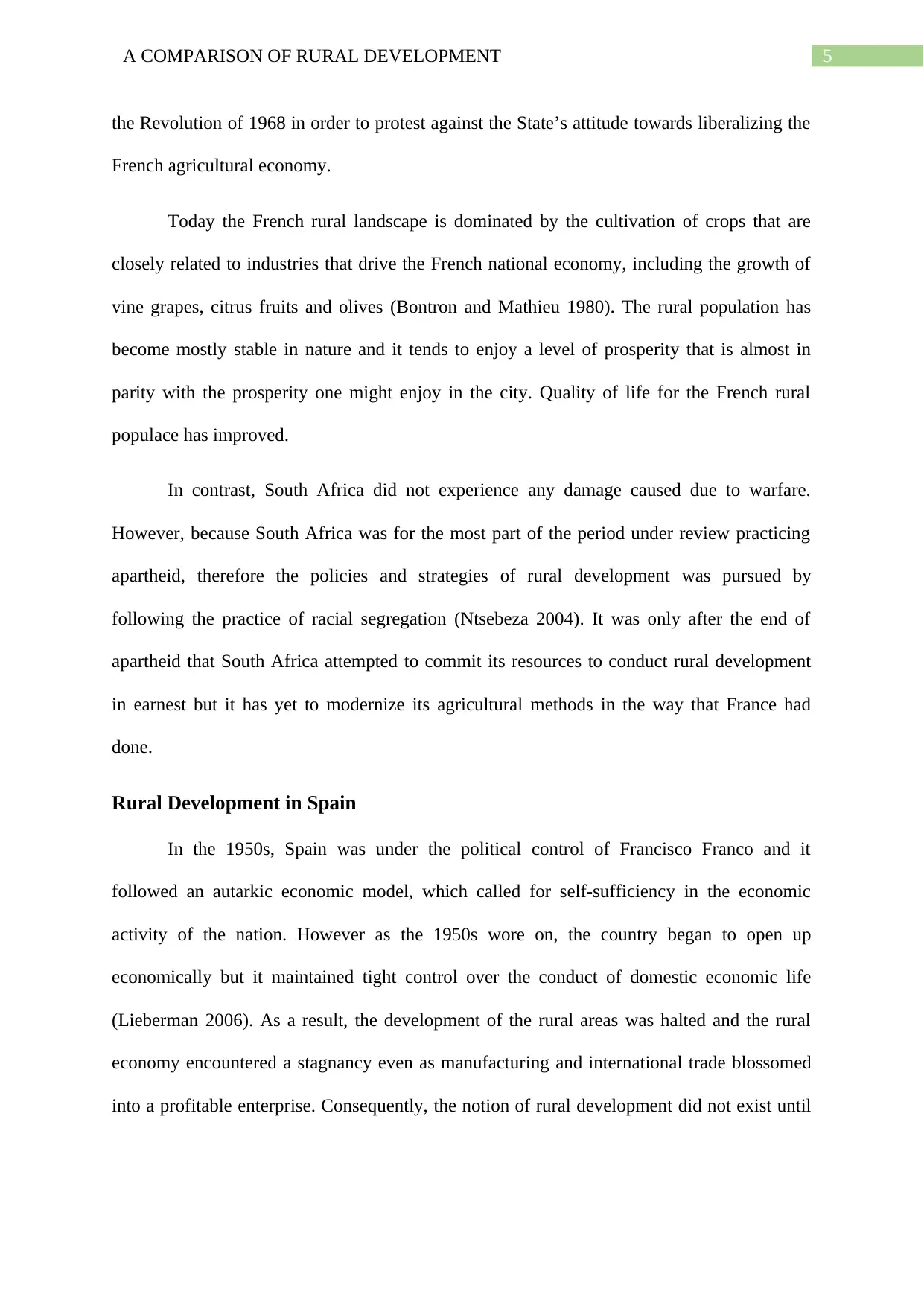
5A COMPARISON OF RURAL DEVELOPMENT
the Revolution of 1968 in order to protest against the State’s attitude towards liberalizing the
French agricultural economy.
Today the French rural landscape is dominated by the cultivation of crops that are
closely related to industries that drive the French national economy, including the growth of
vine grapes, citrus fruits and olives (Bontron and Mathieu 1980). The rural population has
become mostly stable in nature and it tends to enjoy a level of prosperity that is almost in
parity with the prosperity one might enjoy in the city. Quality of life for the French rural
populace has improved.
In contrast, South Africa did not experience any damage caused due to warfare.
However, because South Africa was for the most part of the period under review practicing
apartheid, therefore the policies and strategies of rural development was pursued by
following the practice of racial segregation (Ntsebeza 2004). It was only after the end of
apartheid that South Africa attempted to commit its resources to conduct rural development
in earnest but it has yet to modernize its agricultural methods in the way that France had
done.
Rural Development in Spain
In the 1950s, Spain was under the political control of Francisco Franco and it
followed an autarkic economic model, which called for self-sufficiency in the economic
activity of the nation. However as the 1950s wore on, the country began to open up
economically but it maintained tight control over the conduct of domestic economic life
(Lieberman 2006). As a result, the development of the rural areas was halted and the rural
economy encountered a stagnancy even as manufacturing and international trade blossomed
into a profitable enterprise. Consequently, the notion of rural development did not exist until
the Revolution of 1968 in order to protest against the State’s attitude towards liberalizing the
French agricultural economy.
Today the French rural landscape is dominated by the cultivation of crops that are
closely related to industries that drive the French national economy, including the growth of
vine grapes, citrus fruits and olives (Bontron and Mathieu 1980). The rural population has
become mostly stable in nature and it tends to enjoy a level of prosperity that is almost in
parity with the prosperity one might enjoy in the city. Quality of life for the French rural
populace has improved.
In contrast, South Africa did not experience any damage caused due to warfare.
However, because South Africa was for the most part of the period under review practicing
apartheid, therefore the policies and strategies of rural development was pursued by
following the practice of racial segregation (Ntsebeza 2004). It was only after the end of
apartheid that South Africa attempted to commit its resources to conduct rural development
in earnest but it has yet to modernize its agricultural methods in the way that France had
done.
Rural Development in Spain
In the 1950s, Spain was under the political control of Francisco Franco and it
followed an autarkic economic model, which called for self-sufficiency in the economic
activity of the nation. However as the 1950s wore on, the country began to open up
economically but it maintained tight control over the conduct of domestic economic life
(Lieberman 2006). As a result, the development of the rural areas was halted and the rural
economy encountered a stagnancy even as manufacturing and international trade blossomed
into a profitable enterprise. Consequently, the notion of rural development did not exist until
⊘ This is a preview!⊘
Do you want full access?
Subscribe today to unlock all pages.

Trusted by 1+ million students worldwide
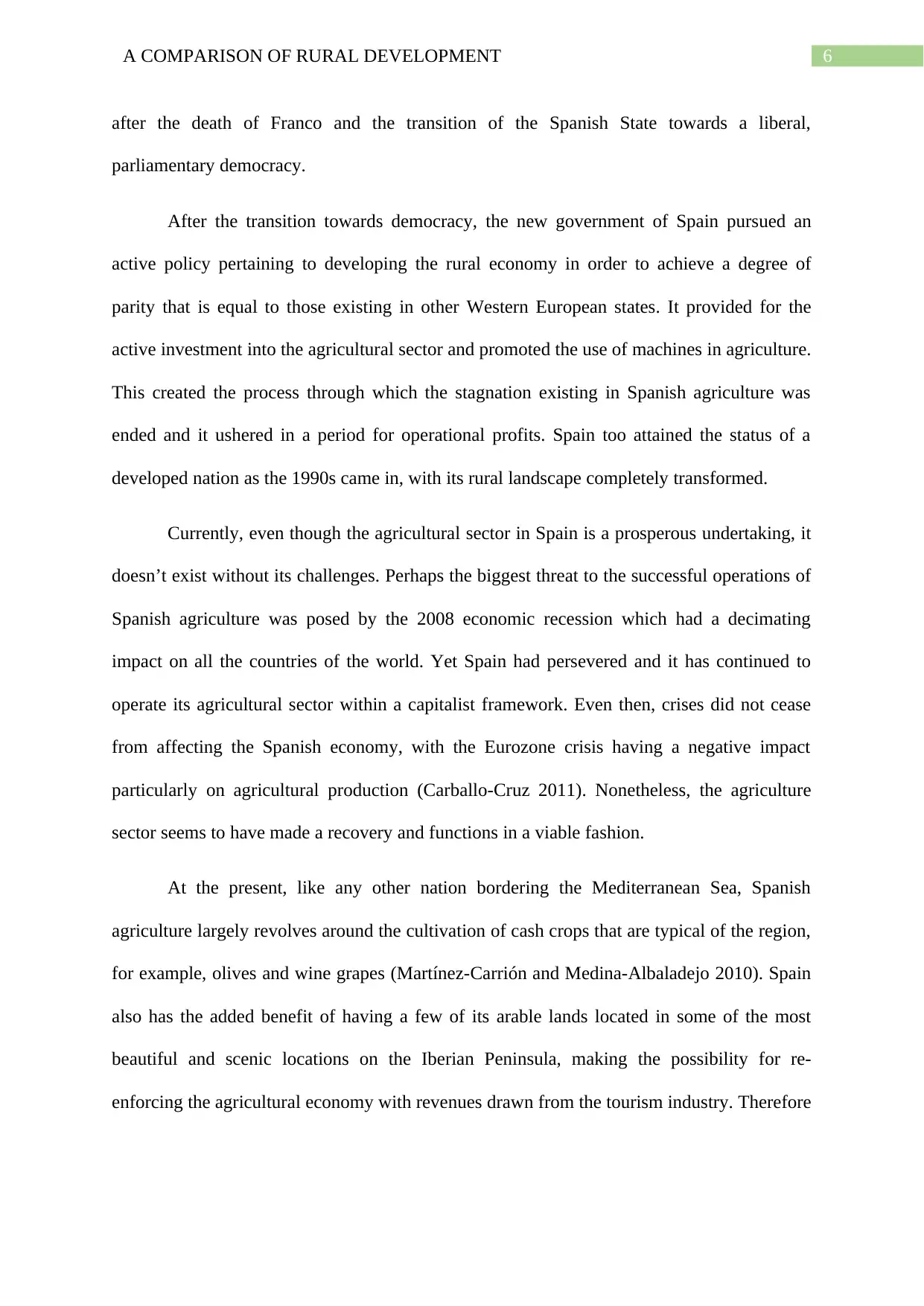
6A COMPARISON OF RURAL DEVELOPMENT
after the death of Franco and the transition of the Spanish State towards a liberal,
parliamentary democracy.
After the transition towards democracy, the new government of Spain pursued an
active policy pertaining to developing the rural economy in order to achieve a degree of
parity that is equal to those existing in other Western European states. It provided for the
active investment into the agricultural sector and promoted the use of machines in agriculture.
This created the process through which the stagnation existing in Spanish agriculture was
ended and it ushered in a period for operational profits. Spain too attained the status of a
developed nation as the 1990s came in, with its rural landscape completely transformed.
Currently, even though the agricultural sector in Spain is a prosperous undertaking, it
doesn’t exist without its challenges. Perhaps the biggest threat to the successful operations of
Spanish agriculture was posed by the 2008 economic recession which had a decimating
impact on all the countries of the world. Yet Spain had persevered and it has continued to
operate its agricultural sector within a capitalist framework. Even then, crises did not cease
from affecting the Spanish economy, with the Eurozone crisis having a negative impact
particularly on agricultural production (Carballo-Cruz 2011). Nonetheless, the agriculture
sector seems to have made a recovery and functions in a viable fashion.
At the present, like any other nation bordering the Mediterranean Sea, Spanish
agriculture largely revolves around the cultivation of cash crops that are typical of the region,
for example, olives and wine grapes (Martínez-Carrión and Medina-Albaladejo 2010). Spain
also has the added benefit of having a few of its arable lands located in some of the most
beautiful and scenic locations on the Iberian Peninsula, making the possibility for re-
enforcing the agricultural economy with revenues drawn from the tourism industry. Therefore
after the death of Franco and the transition of the Spanish State towards a liberal,
parliamentary democracy.
After the transition towards democracy, the new government of Spain pursued an
active policy pertaining to developing the rural economy in order to achieve a degree of
parity that is equal to those existing in other Western European states. It provided for the
active investment into the agricultural sector and promoted the use of machines in agriculture.
This created the process through which the stagnation existing in Spanish agriculture was
ended and it ushered in a period for operational profits. Spain too attained the status of a
developed nation as the 1990s came in, with its rural landscape completely transformed.
Currently, even though the agricultural sector in Spain is a prosperous undertaking, it
doesn’t exist without its challenges. Perhaps the biggest threat to the successful operations of
Spanish agriculture was posed by the 2008 economic recession which had a decimating
impact on all the countries of the world. Yet Spain had persevered and it has continued to
operate its agricultural sector within a capitalist framework. Even then, crises did not cease
from affecting the Spanish economy, with the Eurozone crisis having a negative impact
particularly on agricultural production (Carballo-Cruz 2011). Nonetheless, the agriculture
sector seems to have made a recovery and functions in a viable fashion.
At the present, like any other nation bordering the Mediterranean Sea, Spanish
agriculture largely revolves around the cultivation of cash crops that are typical of the region,
for example, olives and wine grapes (Martínez-Carrión and Medina-Albaladejo 2010). Spain
also has the added benefit of having a few of its arable lands located in some of the most
beautiful and scenic locations on the Iberian Peninsula, making the possibility for re-
enforcing the agricultural economy with revenues drawn from the tourism industry. Therefore
Paraphrase This Document
Need a fresh take? Get an instant paraphrase of this document with our AI Paraphraser
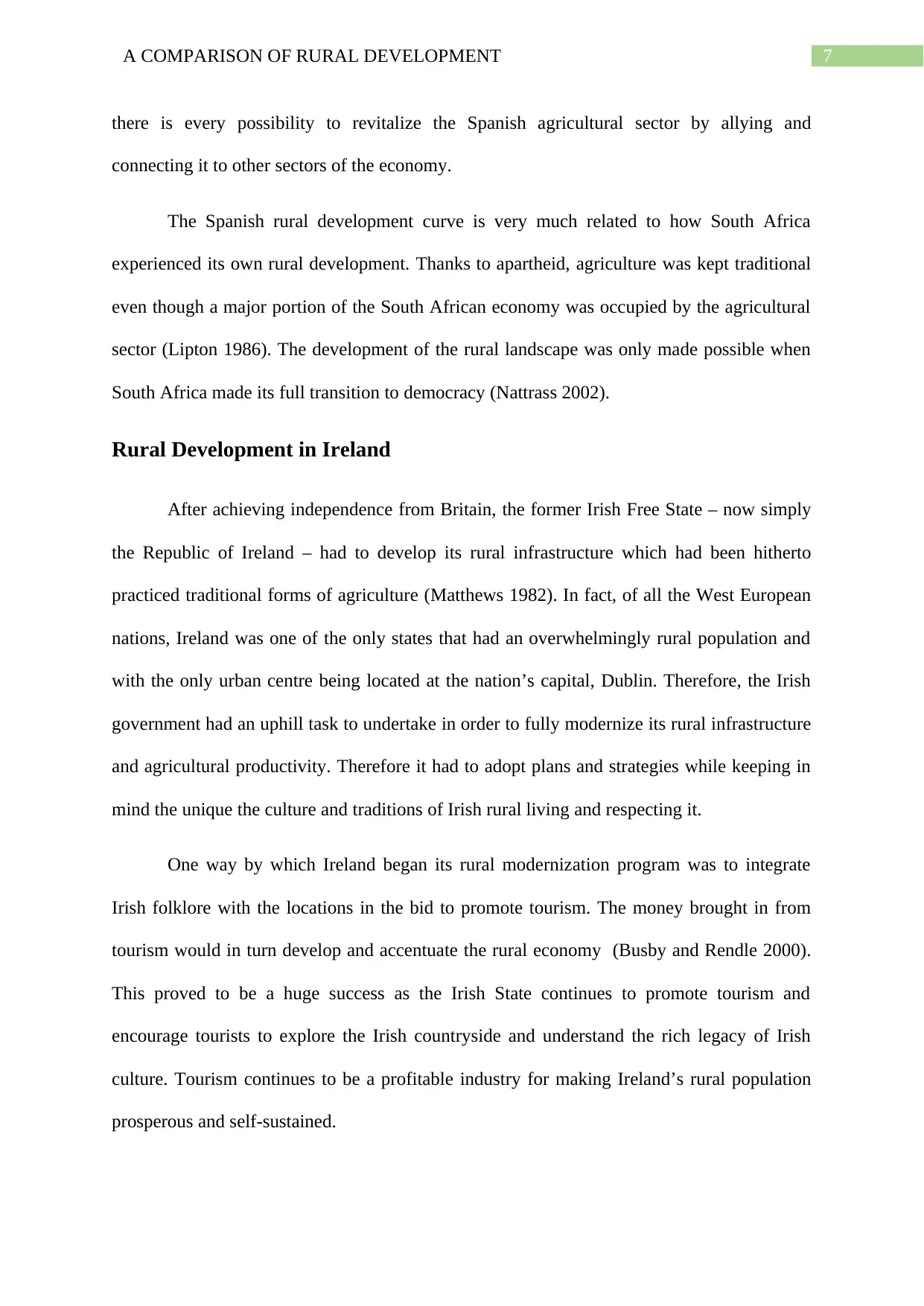
7A COMPARISON OF RURAL DEVELOPMENT
there is every possibility to revitalize the Spanish agricultural sector by allying and
connecting it to other sectors of the economy.
The Spanish rural development curve is very much related to how South Africa
experienced its own rural development. Thanks to apartheid, agriculture was kept traditional
even though a major portion of the South African economy was occupied by the agricultural
sector (Lipton 1986). The development of the rural landscape was only made possible when
South Africa made its full transition to democracy (Nattrass 2002).
Rural Development in Ireland
After achieving independence from Britain, the former Irish Free State – now simply
the Republic of Ireland – had to develop its rural infrastructure which had been hitherto
practiced traditional forms of agriculture (Matthews 1982). In fact, of all the West European
nations, Ireland was one of the only states that had an overwhelmingly rural population and
with the only urban centre being located at the nation’s capital, Dublin. Therefore, the Irish
government had an uphill task to undertake in order to fully modernize its rural infrastructure
and agricultural productivity. Therefore it had to adopt plans and strategies while keeping in
mind the unique the culture and traditions of Irish rural living and respecting it.
One way by which Ireland began its rural modernization program was to integrate
Irish folklore with the locations in the bid to promote tourism. The money brought in from
tourism would in turn develop and accentuate the rural economy (Busby and Rendle 2000).
This proved to be a huge success as the Irish State continues to promote tourism and
encourage tourists to explore the Irish countryside and understand the rich legacy of Irish
culture. Tourism continues to be a profitable industry for making Ireland’s rural population
prosperous and self-sustained.
there is every possibility to revitalize the Spanish agricultural sector by allying and
connecting it to other sectors of the economy.
The Spanish rural development curve is very much related to how South Africa
experienced its own rural development. Thanks to apartheid, agriculture was kept traditional
even though a major portion of the South African economy was occupied by the agricultural
sector (Lipton 1986). The development of the rural landscape was only made possible when
South Africa made its full transition to democracy (Nattrass 2002).
Rural Development in Ireland
After achieving independence from Britain, the former Irish Free State – now simply
the Republic of Ireland – had to develop its rural infrastructure which had been hitherto
practiced traditional forms of agriculture (Matthews 1982). In fact, of all the West European
nations, Ireland was one of the only states that had an overwhelmingly rural population and
with the only urban centre being located at the nation’s capital, Dublin. Therefore, the Irish
government had an uphill task to undertake in order to fully modernize its rural infrastructure
and agricultural productivity. Therefore it had to adopt plans and strategies while keeping in
mind the unique the culture and traditions of Irish rural living and respecting it.
One way by which Ireland began its rural modernization program was to integrate
Irish folklore with the locations in the bid to promote tourism. The money brought in from
tourism would in turn develop and accentuate the rural economy (Busby and Rendle 2000).
This proved to be a huge success as the Irish State continues to promote tourism and
encourage tourists to explore the Irish countryside and understand the rich legacy of Irish
culture. Tourism continues to be a profitable industry for making Ireland’s rural population
prosperous and self-sustained.
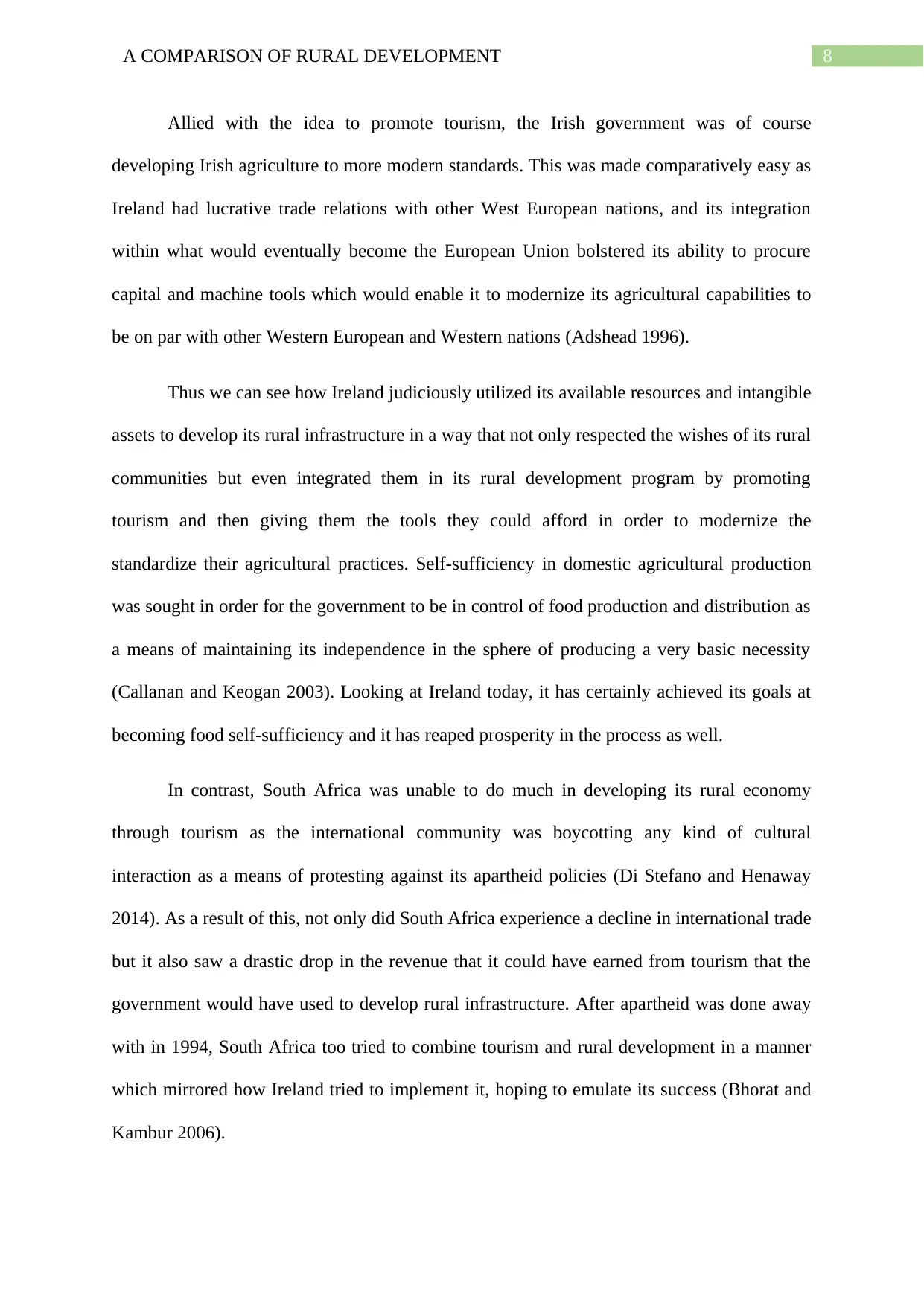
8A COMPARISON OF RURAL DEVELOPMENT
Allied with the idea to promote tourism, the Irish government was of course
developing Irish agriculture to more modern standards. This was made comparatively easy as
Ireland had lucrative trade relations with other West European nations, and its integration
within what would eventually become the European Union bolstered its ability to procure
capital and machine tools which would enable it to modernize its agricultural capabilities to
be on par with other Western European and Western nations (Adshead 1996).
Thus we can see how Ireland judiciously utilized its available resources and intangible
assets to develop its rural infrastructure in a way that not only respected the wishes of its rural
communities but even integrated them in its rural development program by promoting
tourism and then giving them the tools they could afford in order to modernize the
standardize their agricultural practices. Self-sufficiency in domestic agricultural production
was sought in order for the government to be in control of food production and distribution as
a means of maintaining its independence in the sphere of producing a very basic necessity
(Callanan and Keogan 2003). Looking at Ireland today, it has certainly achieved its goals at
becoming food self-sufficiency and it has reaped prosperity in the process as well.
In contrast, South Africa was unable to do much in developing its rural economy
through tourism as the international community was boycotting any kind of cultural
interaction as a means of protesting against its apartheid policies (Di Stefano and Henaway
2014). As a result of this, not only did South Africa experience a decline in international trade
but it also saw a drastic drop in the revenue that it could have earned from tourism that the
government would have used to develop rural infrastructure. After apartheid was done away
with in 1994, South Africa too tried to combine tourism and rural development in a manner
which mirrored how Ireland tried to implement it, hoping to emulate its success (Bhorat and
Kambur 2006).
Allied with the idea to promote tourism, the Irish government was of course
developing Irish agriculture to more modern standards. This was made comparatively easy as
Ireland had lucrative trade relations with other West European nations, and its integration
within what would eventually become the European Union bolstered its ability to procure
capital and machine tools which would enable it to modernize its agricultural capabilities to
be on par with other Western European and Western nations (Adshead 1996).
Thus we can see how Ireland judiciously utilized its available resources and intangible
assets to develop its rural infrastructure in a way that not only respected the wishes of its rural
communities but even integrated them in its rural development program by promoting
tourism and then giving them the tools they could afford in order to modernize the
standardize their agricultural practices. Self-sufficiency in domestic agricultural production
was sought in order for the government to be in control of food production and distribution as
a means of maintaining its independence in the sphere of producing a very basic necessity
(Callanan and Keogan 2003). Looking at Ireland today, it has certainly achieved its goals at
becoming food self-sufficiency and it has reaped prosperity in the process as well.
In contrast, South Africa was unable to do much in developing its rural economy
through tourism as the international community was boycotting any kind of cultural
interaction as a means of protesting against its apartheid policies (Di Stefano and Henaway
2014). As a result of this, not only did South Africa experience a decline in international trade
but it also saw a drastic drop in the revenue that it could have earned from tourism that the
government would have used to develop rural infrastructure. After apartheid was done away
with in 1994, South Africa too tried to combine tourism and rural development in a manner
which mirrored how Ireland tried to implement it, hoping to emulate its success (Bhorat and
Kambur 2006).
⊘ This is a preview!⊘
Do you want full access?
Subscribe today to unlock all pages.

Trusted by 1+ million students worldwide
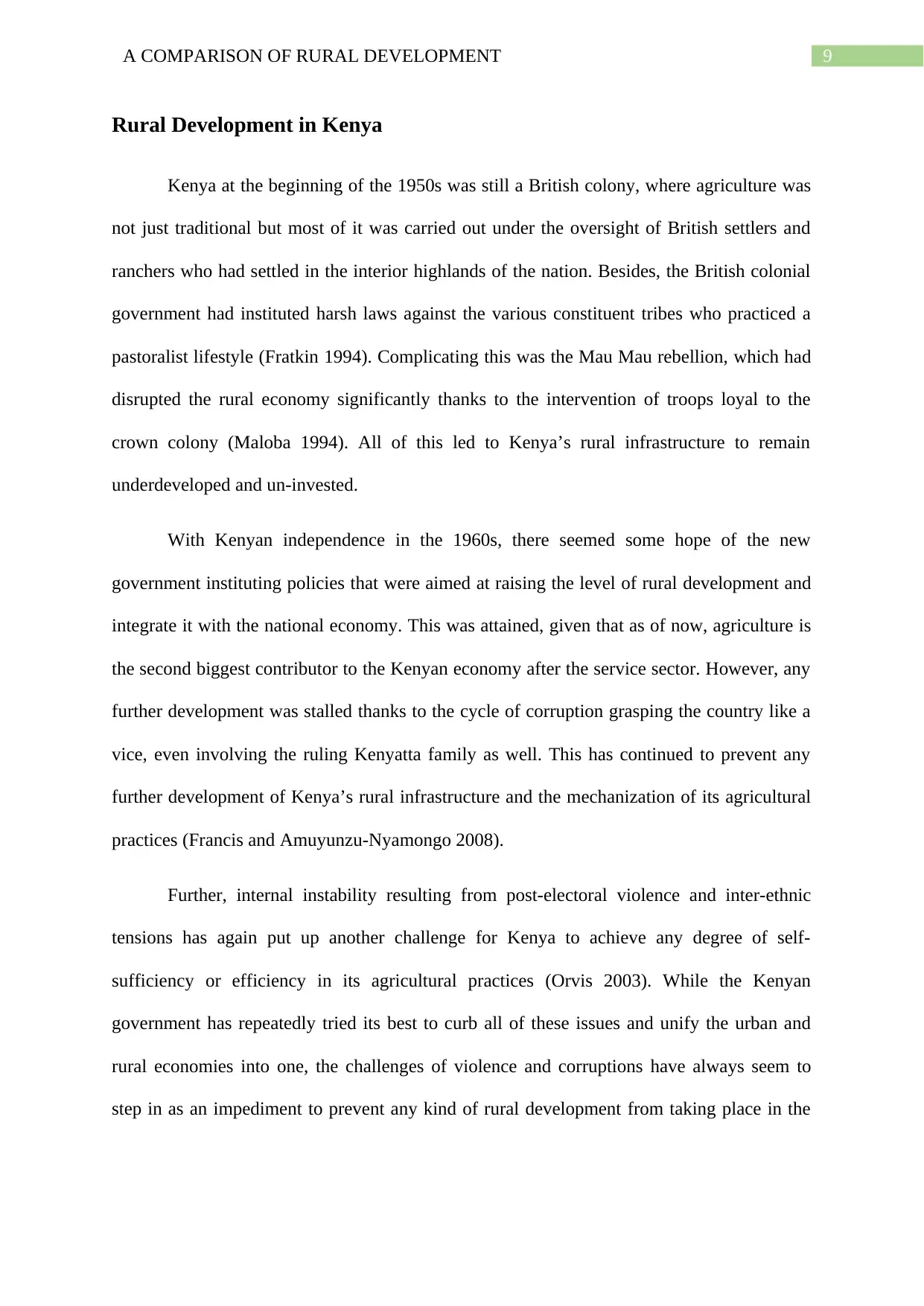
9A COMPARISON OF RURAL DEVELOPMENT
Rural Development in Kenya
Kenya at the beginning of the 1950s was still a British colony, where agriculture was
not just traditional but most of it was carried out under the oversight of British settlers and
ranchers who had settled in the interior highlands of the nation. Besides, the British colonial
government had instituted harsh laws against the various constituent tribes who practiced a
pastoralist lifestyle (Fratkin 1994). Complicating this was the Mau Mau rebellion, which had
disrupted the rural economy significantly thanks to the intervention of troops loyal to the
crown colony (Maloba 1994). All of this led to Kenya’s rural infrastructure to remain
underdeveloped and un-invested.
With Kenyan independence in the 1960s, there seemed some hope of the new
government instituting policies that were aimed at raising the level of rural development and
integrate it with the national economy. This was attained, given that as of now, agriculture is
the second biggest contributor to the Kenyan economy after the service sector. However, any
further development was stalled thanks to the cycle of corruption grasping the country like a
vice, even involving the ruling Kenyatta family as well. This has continued to prevent any
further development of Kenya’s rural infrastructure and the mechanization of its agricultural
practices (Francis and Amuyunzu-Nyamongo 2008).
Further, internal instability resulting from post-electoral violence and inter-ethnic
tensions has again put up another challenge for Kenya to achieve any degree of self-
sufficiency or efficiency in its agricultural practices (Orvis 2003). While the Kenyan
government has repeatedly tried its best to curb all of these issues and unify the urban and
rural economies into one, the challenges of violence and corruptions have always seem to
step in as an impediment to prevent any kind of rural development from taking place in the
Rural Development in Kenya
Kenya at the beginning of the 1950s was still a British colony, where agriculture was
not just traditional but most of it was carried out under the oversight of British settlers and
ranchers who had settled in the interior highlands of the nation. Besides, the British colonial
government had instituted harsh laws against the various constituent tribes who practiced a
pastoralist lifestyle (Fratkin 1994). Complicating this was the Mau Mau rebellion, which had
disrupted the rural economy significantly thanks to the intervention of troops loyal to the
crown colony (Maloba 1994). All of this led to Kenya’s rural infrastructure to remain
underdeveloped and un-invested.
With Kenyan independence in the 1960s, there seemed some hope of the new
government instituting policies that were aimed at raising the level of rural development and
integrate it with the national economy. This was attained, given that as of now, agriculture is
the second biggest contributor to the Kenyan economy after the service sector. However, any
further development was stalled thanks to the cycle of corruption grasping the country like a
vice, even involving the ruling Kenyatta family as well. This has continued to prevent any
further development of Kenya’s rural infrastructure and the mechanization of its agricultural
practices (Francis and Amuyunzu-Nyamongo 2008).
Further, internal instability resulting from post-electoral violence and inter-ethnic
tensions has again put up another challenge for Kenya to achieve any degree of self-
sufficiency or efficiency in its agricultural practices (Orvis 2003). While the Kenyan
government has repeatedly tried its best to curb all of these issues and unify the urban and
rural economies into one, the challenges of violence and corruptions have always seem to
step in as an impediment to prevent any kind of rural development from taking place in the
Paraphrase This Document
Need a fresh take? Get an instant paraphrase of this document with our AI Paraphraser
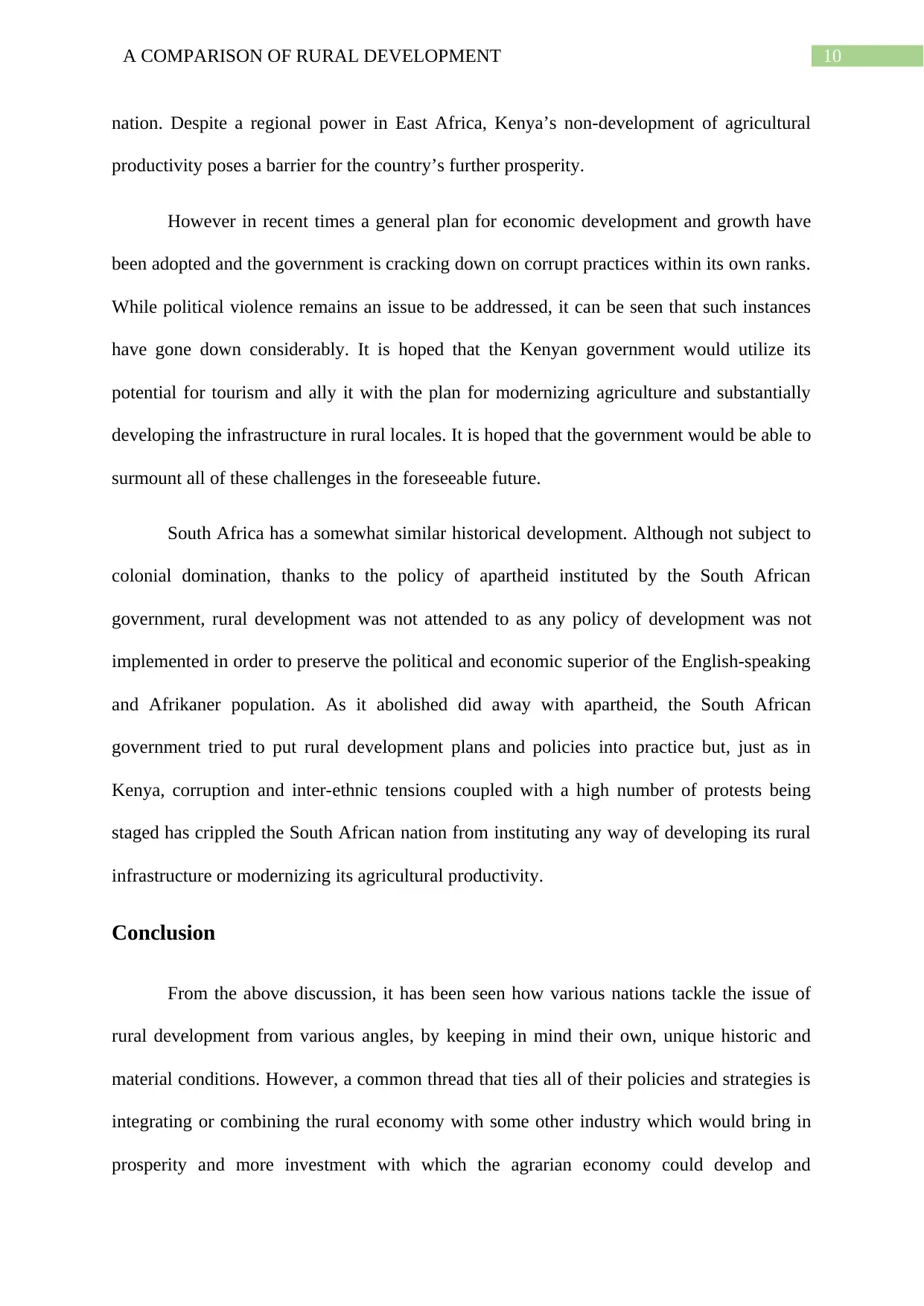
10A COMPARISON OF RURAL DEVELOPMENT
nation. Despite a regional power in East Africa, Kenya’s non-development of agricultural
productivity poses a barrier for the country’s further prosperity.
However in recent times a general plan for economic development and growth have
been adopted and the government is cracking down on corrupt practices within its own ranks.
While political violence remains an issue to be addressed, it can be seen that such instances
have gone down considerably. It is hoped that the Kenyan government would utilize its
potential for tourism and ally it with the plan for modernizing agriculture and substantially
developing the infrastructure in rural locales. It is hoped that the government would be able to
surmount all of these challenges in the foreseeable future.
South Africa has a somewhat similar historical development. Although not subject to
colonial domination, thanks to the policy of apartheid instituted by the South African
government, rural development was not attended to as any policy of development was not
implemented in order to preserve the political and economic superior of the English-speaking
and Afrikaner population. As it abolished did away with apartheid, the South African
government tried to put rural development plans and policies into practice but, just as in
Kenya, corruption and inter-ethnic tensions coupled with a high number of protests being
staged has crippled the South African nation from instituting any way of developing its rural
infrastructure or modernizing its agricultural productivity.
Conclusion
From the above discussion, it has been seen how various nations tackle the issue of
rural development from various angles, by keeping in mind their own, unique historic and
material conditions. However, a common thread that ties all of their policies and strategies is
integrating or combining the rural economy with some other industry which would bring in
prosperity and more investment with which the agrarian economy could develop and
nation. Despite a regional power in East Africa, Kenya’s non-development of agricultural
productivity poses a barrier for the country’s further prosperity.
However in recent times a general plan for economic development and growth have
been adopted and the government is cracking down on corrupt practices within its own ranks.
While political violence remains an issue to be addressed, it can be seen that such instances
have gone down considerably. It is hoped that the Kenyan government would utilize its
potential for tourism and ally it with the plan for modernizing agriculture and substantially
developing the infrastructure in rural locales. It is hoped that the government would be able to
surmount all of these challenges in the foreseeable future.
South Africa has a somewhat similar historical development. Although not subject to
colonial domination, thanks to the policy of apartheid instituted by the South African
government, rural development was not attended to as any policy of development was not
implemented in order to preserve the political and economic superior of the English-speaking
and Afrikaner population. As it abolished did away with apartheid, the South African
government tried to put rural development plans and policies into practice but, just as in
Kenya, corruption and inter-ethnic tensions coupled with a high number of protests being
staged has crippled the South African nation from instituting any way of developing its rural
infrastructure or modernizing its agricultural productivity.
Conclusion
From the above discussion, it has been seen how various nations tackle the issue of
rural development from various angles, by keeping in mind their own, unique historic and
material conditions. However, a common thread that ties all of their policies and strategies is
integrating or combining the rural economy with some other industry which would bring in
prosperity and more investment with which the agrarian economy could develop and
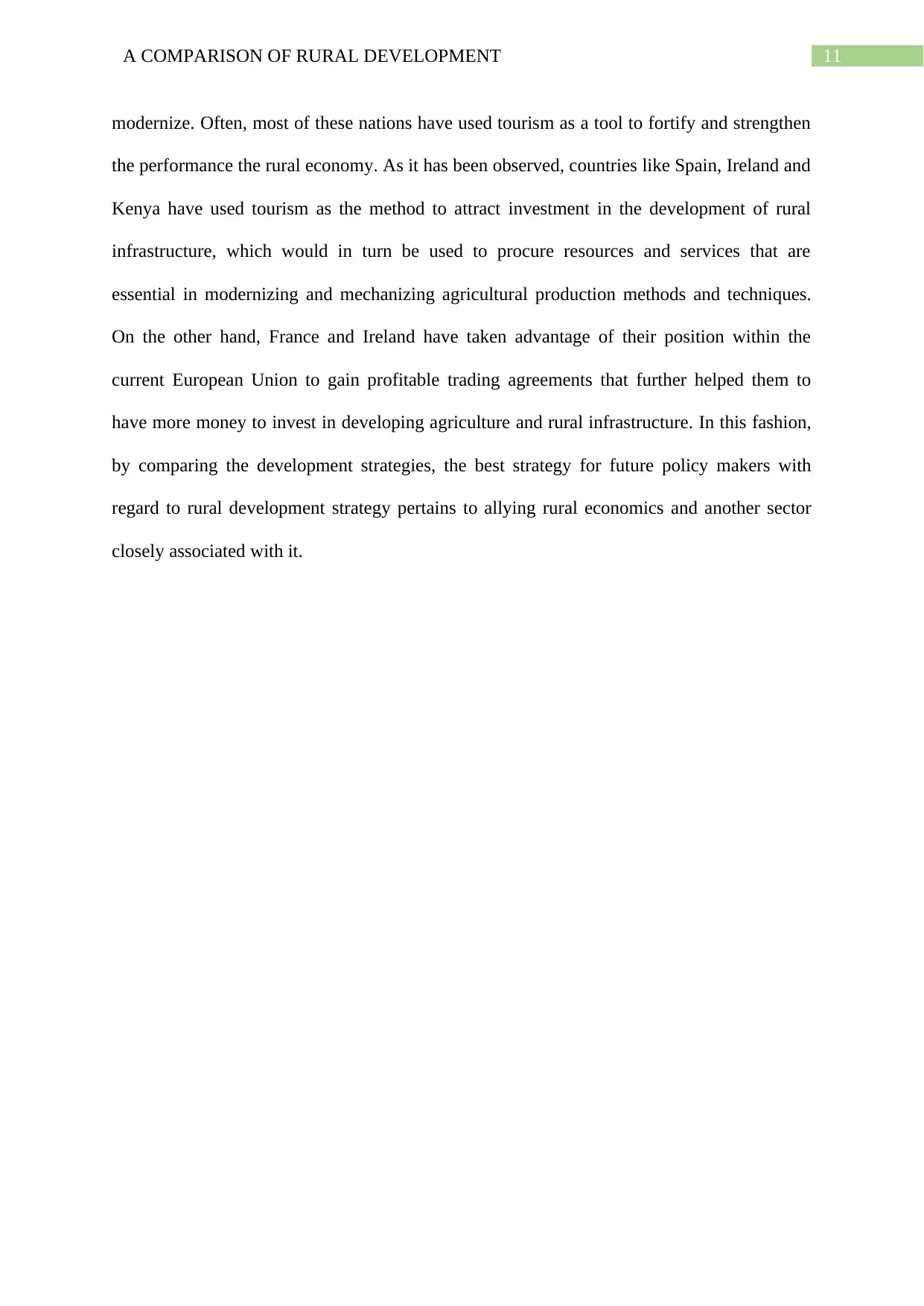
11A COMPARISON OF RURAL DEVELOPMENT
modernize. Often, most of these nations have used tourism as a tool to fortify and strengthen
the performance the rural economy. As it has been observed, countries like Spain, Ireland and
Kenya have used tourism as the method to attract investment in the development of rural
infrastructure, which would in turn be used to procure resources and services that are
essential in modernizing and mechanizing agricultural production methods and techniques.
On the other hand, France and Ireland have taken advantage of their position within the
current European Union to gain profitable trading agreements that further helped them to
have more money to invest in developing agriculture and rural infrastructure. In this fashion,
by comparing the development strategies, the best strategy for future policy makers with
regard to rural development strategy pertains to allying rural economics and another sector
closely associated with it.
modernize. Often, most of these nations have used tourism as a tool to fortify and strengthen
the performance the rural economy. As it has been observed, countries like Spain, Ireland and
Kenya have used tourism as the method to attract investment in the development of rural
infrastructure, which would in turn be used to procure resources and services that are
essential in modernizing and mechanizing agricultural production methods and techniques.
On the other hand, France and Ireland have taken advantage of their position within the
current European Union to gain profitable trading agreements that further helped them to
have more money to invest in developing agriculture and rural infrastructure. In this fashion,
by comparing the development strategies, the best strategy for future policy makers with
regard to rural development strategy pertains to allying rural economics and another sector
closely associated with it.
⊘ This is a preview!⊘
Do you want full access?
Subscribe today to unlock all pages.

Trusted by 1+ million students worldwide
1 out of 14
Your All-in-One AI-Powered Toolkit for Academic Success.
+13062052269
info@desklib.com
Available 24*7 on WhatsApp / Email
![[object Object]](/_next/static/media/star-bottom.7253800d.svg)
Unlock your academic potential
Copyright © 2020–2025 A2Z Services. All Rights Reserved. Developed and managed by ZUCOL.

